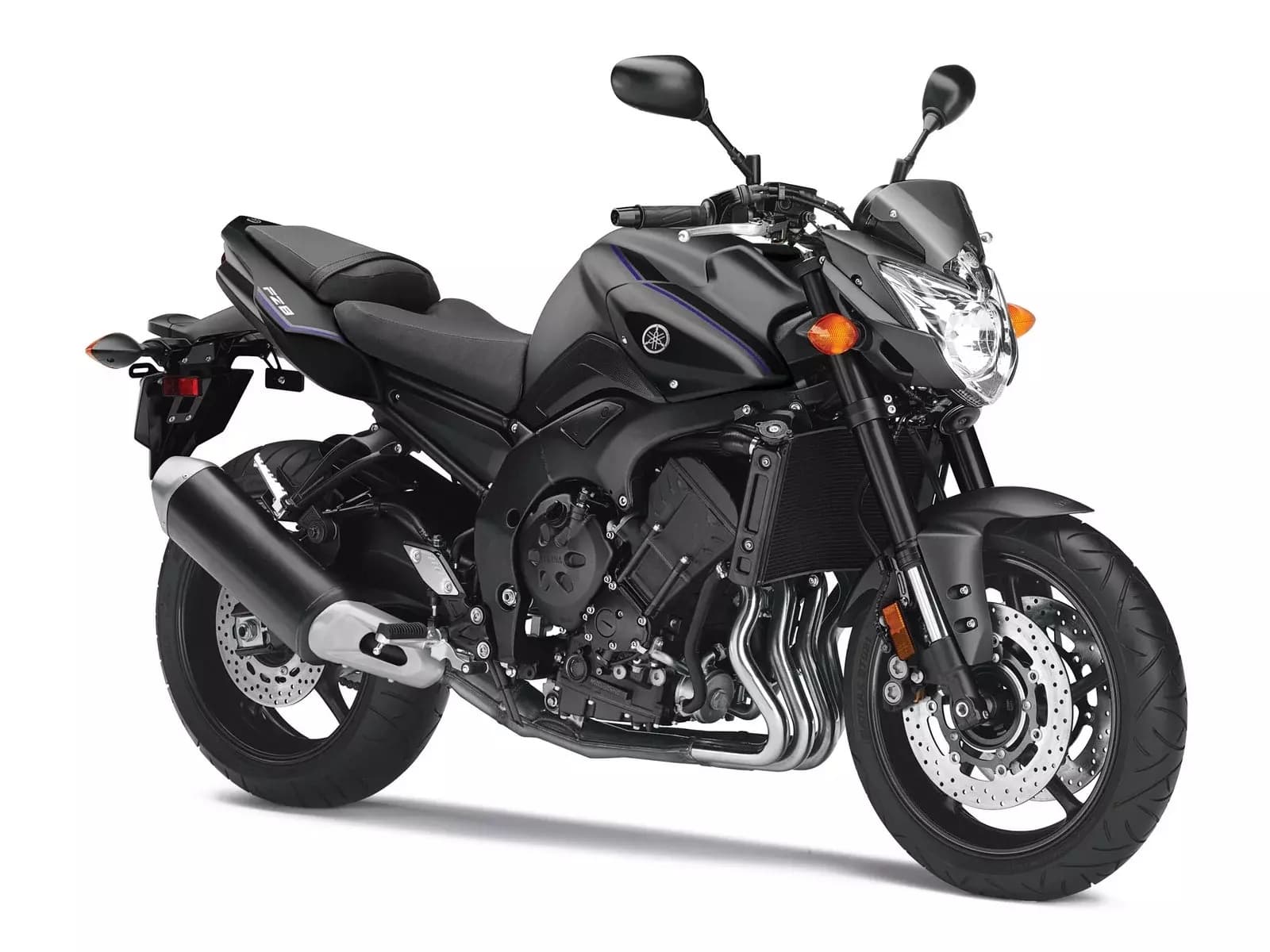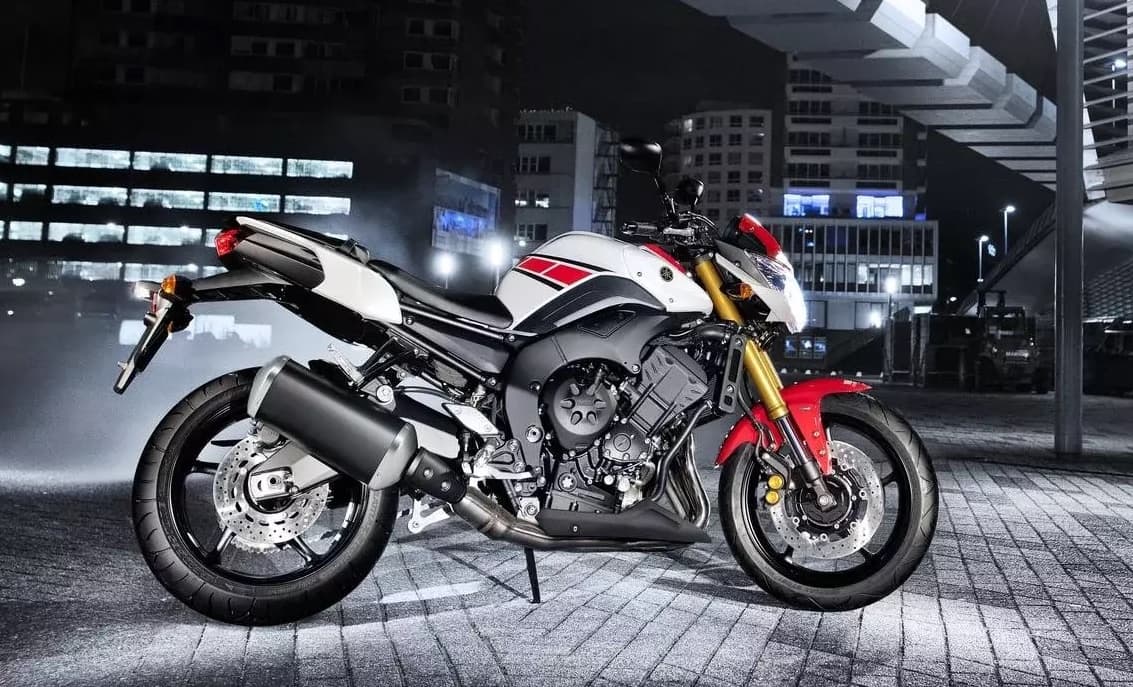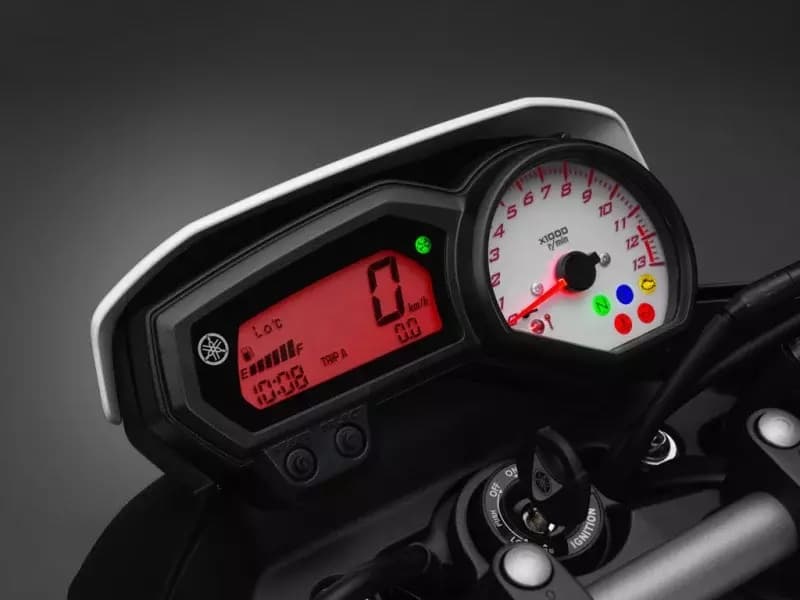Fz 800 Yamaha 2012
This is the maintenance schedule and associated service intervals for the Yamaha FZ8, also known as the FAZER8 in some markets. It was made between 2010 and 2013, and marketed up to 2015, at which point it was no longer sold.
The Yamaha FZ8 took over from the Yamaha FZ6 and FZ6 FAZER. It comes in a couple of forms — the FZ8N as the naked bike, and the FZ8S as a faired bike. Maintenance is the same for both.
The Yamaha FZ8 is powered by a 779cc inline four-cylinder engine that makes 79 kW (106 hp) @ 10,000 rpm, and 58 Nm (78 lb-ft) of torque at 8,000 rpm. So it's a moderately high-revving bike, but not anywhere near as high a screamer as the previous FZ6. Power isn't in another class, but there's more torque everywhere. Because the FZ8's motor was specifically designed for a naked bike, it has a bit of different character to what you'd get in a full-on sports bike.
The FZ8 was eventually replaced by the three-cylinder Yamaha MT-09.

Yamaha FZ8 Fazer8

Yamaha FZ8 FAZER8 lhs diagonal

Yamaha FZ8 red and white 50th anniversary

Yamaha FZ8 50th anniversary RHS at night time
This site has links for things like oil and spark plugs from which we earn a commission (which unfortunately nobody can save, not even us). If you appreciate this work, then please use those links. Thanks!
Yamaha FZ8 Maintenance Schedule
Below is the maintenance schedule for the Yamaha FZ8.
The maintenance for the. Yamaha FZ8 is broken into two sections: periodic maintenance for emission control systems, and general maintenance and lubrication.
Periodic Maintenance Emission Control System
TIP:
- After 20,000 miles or 40,000 kms, keep repeating the maintenance schedule every two periods.
- Mile service intervals come from the US manuals, and KM service intervals come from the Europe/APAC ones.
- Items other than external lubrication and changing the engine oil, marked with an asterisk, (per Yamaha) "require special tools, data and technical skills, have a Yamaha dealer perform the service."
| Item | Miles (US) | 600 | 4000 | 8000 | 12000 | 16000 | 20000 |
|---|---|---|---|---|---|---|---|
| KM (Europe/APAC) | 1000 | 10000 | 20000 | 30000 | 40000 | – | |
| Months | 1 | 6 | 12 | 18 | 24 | 30 | |
| Fuel line* | • Check fuel hoses for cracks or damage. • Replace if necessary. | • | • | • | • | • | |
| Spark plugs* | • Check condition. • Adjust gap and clean. • Replace periodically | • | R | • | R | • | |
| Valve clearance* | • Check and adjust valve clearance when engine is cold (ever 26K miles/40K km) | ||||||
| Crankcase breather system* | • Check breather hose for cracks or damage. • Replace if necessary | • | • | • | • | • | |
| Fuel injection* | • Check and adjust engine idle speed and synchronization. | • | • | • | • | • | • |
| Exhaust system* | •Check for leakage •Tighten if necessary •Replace gasket(s) if necessary | • | • | • | • | • | • |
| Evaporative emission control system* (For California only) | •Check control system for damage •Replace if necessary | • | • | ||||
| Air induction system* | • Check the air cut-off valve, reed valve, and hose for damage. • Replace any damaged parts. | • | • |
General Maintenance and Lubrication Chart
| Item | Miles: (US) | 600 mi | 4000 mi | 8000 mi | 12000 mi | 16000 mi | 20000 mi |
|---|---|---|---|---|---|---|---|
| Item | Km: (Europe, Aust, NZ) | 1000 km | 10000 km | 20000 km | 30000 km | 40000 km | – |
| Months: | 1 | 6 | 12 | 18 | 24 | 30 | |
| Air filter element | • Replace. | ||||||
| Clutch* | • Check operation. • Adjust or replace cable. | • | • | • | • | • | • |
| Front brake* | • Check operation, fluid level, and for fluid leakage. • Replace brake pads if necessary. | • | • | • | • | • | • |
| Rear brake* | • Check operation, fluid level, and for fluid leakage. • Replace brake pads if necessary. | • | • | • | • | • | • |
| Brake hoses* | • Check for cracks or damage. • Check for correct routing and clamping. | • | • | • | • | • | |
| • Replace (every 4 years) | |||||||
| Wheels* | • Check runout and for damage. • Replace if necessary. | • | • | • | • | • | |
| Tires* | • Check tread depth and for damage. • Replace if necessary. • Check air pressure. • Correct if necessary. | • | • | • | • | • | |
| Wheel bearings* | • Check bearings for smooth operation. • Replace if necessary. | • | • | • | • | • | |
| Swingarm pivot bearings* | • Check bearing assemblies for looseness. | • | • | • | • | • | |
| Drive chain* | • Check chain slack/ alignment and condition. • Adjust and lubricate chain (A) (Motul chain paste) | ||||||
| Steering bearings* | • Check bearing assemblies for looseness. | • | • | • | • | • | • |
| • Moderately repack with lithium-soap-based grease. | • | ||||||
| Chassis fasteners* | • Check all chassis fitting and fasteners. • Correct if necessary. | • | • | • | • | • | |
| Brake lever pivot shaft | • Apply silicone grease lightly. | • | • | • | • | • | |
| Brake pedal pivot shaft | • Apply lithium-soap-based grease lightly | • | • | • | • | • | |
| Clutch lever pivot shaft | • Apply lithium-soap-based grease lightly | • | • | • | • | • | |
| Shift pedal pivot shaft | • Apply lithium-soap-based grease lightly | • | • | • | • | • | |
| Sidestand pivot | • Check operation. • Apply lithium soap-based grease lightly. | • | • | • | • | • | |
| Sidestand switch* | • Check operation and replace if necessary. | • | • | • | • | • | • |
| Front fork* | • Check operation and for oil leakage. • Replace if necessary. | • | • | • | • | • | |
| Shock absorber assembly* | • Check operation and for oil leakage. • Replace if necessary. | • | • | • | • | • | |
| Rear suspension link pivots* | • Check operation. • Correct if necessary. | • | • | ||||
| Engine oil | • Change — use Yamalube 10W-40 | • | • | • | • | • | • |
| Engine oil filter cartridge* | • Replace — use HF204RC | • | • | • | |||
| Cooling system* | • Check hoses for cracks or damage. • Replace if necessary. | • | • | • | • | • | |
| • Change with ethylene glycol coolant every 24 months. | • | ||||||
| Front and rear brake switches* | • Check operation. | • | • | • | • | • | • |
| Control cables* | • Apply cable lubricant thoroughly | • | • | • | • | • | • |
| Throttle grip* | • Check operation. • Check throttle grip free play, and adjust if necessary. • Lubricate cable and grip housing. | • | • | • | • | • | |
| Lights, signals and switches* | • Check operation. • Adjust headlight beam. | • | • | • | • | • | • |
Tip:
- Chain: Clean/lubricate chain Every 500 mi (800 km) and after washing the motorcycle or riding in the rain or riding in wet areas.
- Air filter
- This model's air filter is equipped with a disposable oil-coated paper element, which must not be cleaned with compressed air to avoid damaging it.
- Replace the air filter every 24000 mi or 40,000 km.
- The air filter element needs to be replaced more frequently when riding in unusually wet or dusty areas
- Hydraulic brake service
- After disassembling the brake master cylinders and calipers, always change the fluid. Regularly check the brake fluid level and fill the reservoirs as required.
- Every two years replace the internal components of the brake master cylinder and calipers, and change the brake fluid.
- Replace the brake hoses every four years, or if cracked or damaged.
About the Yamaha FZ8
The Yamaha FZ8 is a more powerful but also heavier replacement for the Yamaha FZ6.
The FZ8 was Yamaha's first answer to the question: how can we build a middleweight motorcycle that's fun to ride and doesn't feel like a superbike motor in an upright chassis?
Unlike the FZ6, which has an R6 engine tuned for street use, the FZ8 has an engine from the already-in-production FZ1, but with reduced bore, bringing capacity down to 779cc. The aluminium frame and swingarm are also from the FZ1.
The result is a lower-power FZ1 but with a chassis and engine that's much the same weight. The FZ1 weighed 220kg, and the FZ8 weighted 212kg (both wet). So it left a lot of reviewers asking: why?
Well, the answer is because the FZ8 is still a lot of motorcycle for most people. Reviewers got it from 0-100 km/h in less than 3.5 seconds — which is faster than most supercars.
Additionally, because the FZ8 is more tuned for midrange torque rather than top-end power (of which it still has plenty!), the FZ8 is just a lot more suitable for riding in that sweet spot of fun between 60 and 160 km/h, where most people live (and rarely even at the top end of that).

The FZ8 came with optional ABS, and the FAZER8 came with it standard.
The FZ8 got an update in its chassis in 2013 that means that frankly, you should only buy the 2013+ FZ8. The 2010-2012 FZ8 had non-adjustable front forks, and rear suspension that was only preload adjustable. But in 2013, the FZ8 got a fully adjustable front fork and a better exhaust can to boot, plus a preload and compression damping adjustable rear shock which also came with a stiffer spring.
The FZ8 sold reasonably well, though nowhere near as well as the inline triple that replaced it in the FZ-09 or MT-09.
Manual for the Yamaha FZ8

The above information was gleaned from the owner's manual for the Yamaha FZ8.
You can download it from Yamaha's website here.
Source: https://maintenanceschedule.net/yamaha-fz8-maintenance-schedule/

Tidak ada komentar: